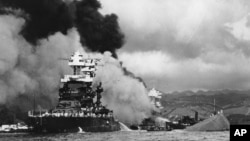Three-quarters of a century after he was killed during the surprise Japanese attack on Pearl Harbor, the remains of a young Navy sailor are heading home to Kansas.
Lewis Lowell Wagoner was a 20-year-old Navy seaman second class when he died and was declared missing after the Dec. 7, 1941, attack that propelled the United States into World War II. Wagoner was aboard the USS Oklahoma when it, along with other U.S. warships, was doomed by torpedoes while moored in Pearl Harbor.
Wagoner’s body, unidentified at the time, was recovered, along with several hundred fellow shipmates. All of them were buried as unknowns in a Hawaii cemetery. But last year, the U.S. military dug up the mass graves and began a painstaking push by special military laboratories to put names to the remains, using prewar dental records and modern advances in DNA testing.
Wagoner’s remains are to be flown Friday to Wichita, Kansas, a day before a memorial service and interment with military honors at a family plot in Harvey County’s Whitewater Cemetery. A bronze grave marker, noting the Missouri-born serviceman’s status as a Purple Heart recipient, awaits him in a row of final resting places for three of his seven brothers. Just one brother, 87-year-old Carl Wagoner of Syracuse, Utah, is still living.
While saying “it’s a joy that we’re finally able to bring Uncle Lewis home,” 70-year-old Wichita niece Linda Guinn called it bittersweet in that only one sibling is able see it happen.
“When his brothers all were younger, they were always talking about Lewis and wondering if he could ever be brought home,” said Doris Wagoner, Lewis Wagoner’s sister-in-law. Her husband, Merle Wagoner, a Navy veteran of the Korean War, died three years ago at the age of 79.
Heavy casualties
Japanese planes hit the Oklahoma with a blitz of torpedoes, quickly capsizing the battleship. Thirty-two men were rescued via holes cut through the hull, but 415 sailors and 14 Marines didn’t make it.
All told, more than 2,400 sailors, Marines and soldiers died in the Pearl Harbor attack that sank or damaged 21 U.S. vessels. The Oklahoma’s casualties were second only to the USS Arizona, which lost 1,177 men.
The Pentagon has offered no public account about how Wagoner died, though Guinn said a shipmate friend of Wagoner’s has said the two men dove off the torpedo-ravaged ship into the water ablaze with leaking oil and fuel. The friend survived and since has died; Wagoner wasn’t a good swimmer and was never seen alive again, Guinn said.
The Navy spent more than two years recovering remains from the Oklahoma. But last year, the Pentagon's Defense POW/MIA Accounting Agency began unearthing the remains from 45 grave sites, disinterring 61 caskets, many containing comingled remains of multiple people.
On Sept. 30, the agency announced that scientists had identified Wagoner’s remains through dental comparisons and DNA that matched two brothers, who relatives said supplied genetic samples to the military about a decade ago.
Another sailor returns home
The same day, the agency also announced it had identified the remains of Navy Lt. j.g. Aloysius Schmitt of St. Lucas, Iowa, who was also aboard the Oklahoma. A visitation was held for the chaplain Wednesday in his hometown and a burial will be held in Dubuque, Iowa, on Saturday, The Telegraph Herald newspaper reported.
Schmitt was among a group of sailors who discovered a small porthole as the ship was filling with water. He had the chance to escape but refused and hoisted others through the porthole and out to safety, according to the newspaper.
By 2020, the accounting agency expects to identify 80 percent of the Oklahoma’s unknown.









